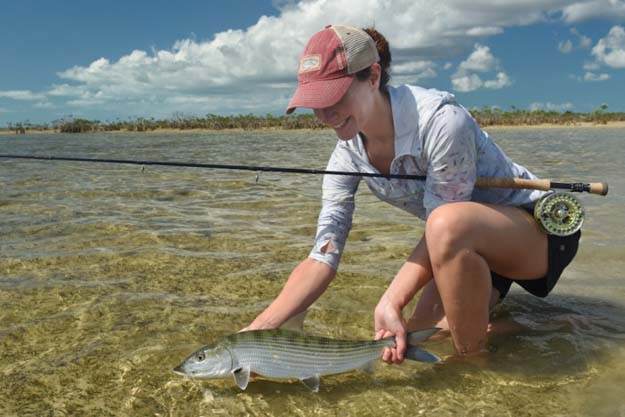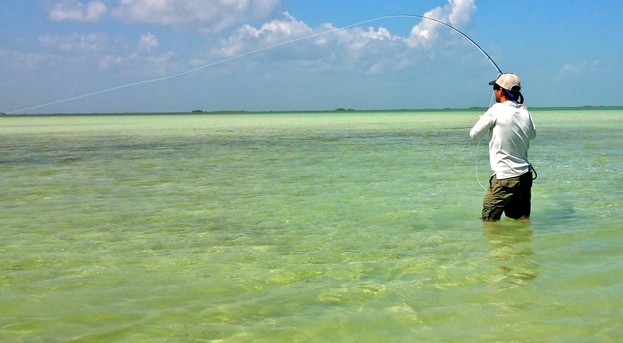
Photo by Yellow Dog Fly Fishing took at H2O Bonefishing & Pelican Bay Resort, Grand Bahama, The Bahamas.
No matter your angling prowess, planning for a bonefishing trip has a few unique considerations
By Skip Clement, Contributor
[dropcap]B[/dropcap]onefishing is a special experience but without proper preparations and guidance it can go from relaxing to fatiguing in a hurry.
Technically, you can bring everything including the kitchen sink aboard a “boat,” but, of course, that’s not practical. What you do bring aboard is your supply depot for both afloat and afoot angling the flats.
If your destination is The Bahamas, stay in one of the well established Grand Bahama lodges or one of the many well established out-island lodges that embrace foreign anglers. In the hands of a well-established lodge, you’re not going to be hampered by the new flats fishing rules, bothered by fools or in any way hassled.
If you know your way around The Bahamas lodge scene, great, but a word to the wise is thinking to make fool-proof arrangements through the top outdoor travel companies, fly shops or individuals with credible connections.
If Mexico or Belize is your destination, there are no populists in-power or Draconian rules designed to punish foreigners. Cuba, of course, newly minted, entered our angling world only to be discombobulated by the Discombobulator-in-charge. Now, planning a trip, there are even more alerts for special consideration.
You might want to ditch what you think you know, take a step back, and listen to the wisdom of well-worn travelers
Those keen observations about the transitional needs of a waded flat versus a skiff approach to bonefishing can best be realized by listening to travelers with well-worn passports, ones with many ingresses and egress stamps to Mexico, Cuba, Belize, Bahamas, Vieques, Seychelles or other known bonefish ports of the world.
Here’s what the real pros have to say about what “essentials” to bring for flats and skiff bonefish outing. You‘re on your own remembering meds, passport, viagra, lipstick, lip balm, sunscreen, tropical under and outerwear, toothpaste and et al. minutiae.
Listed here are “essentials” – the things you need to complete the mission of catching bonefish.
The authors have been chosen because they have fished the referenced destinations more times than you own pairs of socks. No better professional “traveler” advice is available.
Urban Angler:
Jon Fisher’s Urban Angler in New York City is the perfect fly shop provider and trip host for excursions to unique destinations. Our editor, Captain Andrew Derr, former GM at Urban Angler was host/guide for multiple anglers visiting the rich Seychelles flats, casting to big bones and other Jurassic size shallow water visitors. He said: “Urban Angler can provide an angler with all the essentials needed for any bonefish trip.”
Urban Angler has a who’s who Wall Street and Broadway theater clientel and they don’t just fish locally, they fly to their fishing destinations and more often than not necessitating a passport. Andrew adding: “Jon’s clients don’t skimp, but he sees to it that they don’t waste money on non-essentials.”
The most important items when going on a bonefish trip:
• At least one 8- or 9-weight. Ideally a powerful rod for generating line speed in windy conditions.
• At least one fly reel built for use in saltwater with enough capacity for the fly line plus 200 yards of backing.
• Plenty of water to drink.
• Bonefish specific fly line – perhaps the most critical item! These special lines are specifically designed for use in tropical saltwater conditions.
• 10- to 16-pound test / 9- and 12-foot Tapered Bonefish Leaders. Knotted leaders are great, but the knots often get caught up in the turtle grass… Very frustrating!
• Fishing pliers that can cut mono, crimp barbs, and remove hooks from fish. You won’t realize how important a good pair of pliers is until you need them!
• Polarized sunglasses are critical not only for eye protection but for spotting fish! Best lens colors for sight fishing are Copper, Brown, and Amber.
• Buff or a similar head and neck cover to protect again the searing sun during a full day on the flats. Sunscreen, of course.
• An assortment of well-known bonefish flies.
Items unique to wading bonefish flats:
• Flats booties or saltwater wading boots. Flats boots are essential for comfortably wading.
• Waterproof backpack, sling, or waist Pack – what you will be carrying with you will eventually get wet!
Items specific to bonefishing from a skiff:
• Waterproof Boat Bag – what you’re carrying with you will eventually get wet!
• Raincoat.
• Bug spray.

No, it is not Colorado, but it is Lower Manhattan in New York City. Urban Angler is a not so typical fly shop – one fly shop in New York City to accommodate 8 million people. Don’t strain to see store front – they are on the 2nd floor. Urban Angler image.
Deneki:
Note: Several items were removed as being non-essential, but their blog posted list was not presented as “essential” – as we requested.
Deneki, uniquely, owns all of the properties it represents. Their only bonefishing property is Andros South.
On Your Person:
• At a minimum, a fast-action 8-weight for bonefish.
• Large arbor, sealed-smooth drag, and tropical fly lines.
• Pliers or hemostats, including nippers or scissors.
• Tippet spools.
• Flies. They might be in a really nice box, and they might be in a crappy little Ziplock, but you need at least a handful of flies to be prepared for light and dark bottoms (light and dark flies), shallow and deep flats (light and heavy flies), and for those cases when you get broken off and need to re-tie.
• Hip Pack
• Water. Be smart.
• Expanded fly selection. Maybe some unweighted flies, maybe some permit flies, maybe that double-secret fly tied by your Uncle Merlin.
• Spare leaders or material for tying more leaders. Sometimes a big fish swims around a mangrove, and you lose the whole shootin’ match – you need to be prepared to re-rig.
• Buff, if you’re not wearing it already. It’s a good idea to stay out of the sun, and Buffs help.
• Lens Cloth. It’s teensy and light, and you’ll see a lot better, which matters when you’re chasing bonefish.
In Your Boat Bag:
• Raincoat.
• Wire Leader and Barracuda Flies
• Flats Boots and Socks.
• Bug Spray.
• Sunglasses with different tints. Yes, it’s getting a little technical, but darker lenses are better when the sun is raging, and yellow or rose lenses are better when it’s cloudy.
• Extra fly line. Sometimes things go wrong, and your fly line falls victim to a coral head or a nasty mangrove or a giant bonefish. It’s pretty easy to pack an extra line along, just in case.
Frontiers:
Joe Codd is the company’s Saltwater Department Manager – a true veteran of the bonefishing experience. He knows just about everything there is to know about bonefishing, the bonefisher’s essential needs, and best accommodations.
The Bonefish rod we recommend highly is the Sage Salt HD 9’ x 8-weight – paired with the new Sage Spectrum LT 7/8 Reel and a RIO Directcore Flats Pro weight forward floating line. Leader would be a RIO Flouroflex Bonefish/Saltwater tapered to 12-pounds
Flies
McVays Gotcha
Veverkas Mantis Shrimp
Puglisi Spawning Shrimp
Tan Crazy Charlie
Size 4 as a starting point
Other
• A solid sling pack or fishing backpack that you can grab when leaving the skiff to wade fish. I like the waterproof variety, but some may find it a bit redundant if they’re utilizing a waterproof boat bag. To each their own.
• The pack should be capable of storing the rest of the items I always take along a Nalgene water bottle, or two (mandatory)
• Crystal Light lemonade packets or Squincher packets to flavor up your water. They take up no room and are a great break from boring H2O. They tend to make hydrating easier for some people who just aren’t water drinkers.
• Lightweight rain jacket
• Wide brimmed hat. Baseball caps are great, but a nice packable “floppy” hat or a cheap disposable-type straw hat purchased en-route to the lodge provide far better coverage.
• A small well-thought-out First-Aid kit that will fit in a small fly box.
• Plenty of small bills for tipping baggage handlers, taxi drivers and the like. Especially important for those long haul destinations with multiple legs, transfers, etc.
• Rugged pair of wading boots like the Marl Walkers or Flats Sneakers
• Neoprene socks for anti-chafing inside the wading boots
• Anti-chafing balm . . . Self-explanatory and can be a real trip saver for those wading all day every day
• Copy of your picture page of your passport kept separate from the real thing. Again, a trip saver if something is lost or stolen.
• Pre-packaged snacks such as jerky and those small bags of peanuts or trail mix that you can buy in quantity from Costco or Sam’s Club. Great to have when you’re 3 miles from the boat and haven’t eaten in hours.
• Small handheld GPS devices can be very useful in case of emergencies. They take up no room and can help get you out of a bind if you need to either relay coordinates to someone or make it back sans guide. Accidents happen.
Yellow Dog Fly Fishing:
• Medium to fast action high modules graphite rod. Practice casting with minimal false casts and accurate with-in 50 feet. An eight weight is the ideal all-around bonefish rod.
• Large abhor reel with sealed disc drag system.
• Weight forward floating fly line – aggressive front taper to power through the wind. Anglers new to salt may choose to overweight the line by one weight (9 weight line on an eight weight)
• Ten-foot fluorocarbon leader down to 15-or 16-pound tippet – 12-, 15-, and 20-pound fluoro tippet spools.
• Flies in a range of color from darker brown to white. Two weight classes – bead chain and dumbbell eyes. Size 4 chain eyed Gotcha is #1 for bones. EP Spawning shrimp is also a must have.
• Polarized sunglasses – tan or vermillion glass lens with good side cover.
• Rain jacket and waterproof boat bag.
• Line cleaner to remove gritty salt and sand. Do it daily.
Wade fishing (beyond above)
• Quality saltwater boots to walking the flats. Ridged sole for walking across hard coral.
• Waterproof sling or hip pack.
• Small selection of lighter weighted flies
• Water
Boat fishing (beyond above)
• Knowledge of the clock system for locating fish the guide is seeing.
• A buddy to maintain your line when casting and hooking a fish. A line tamer bucket or mat if you are alone.
• Determine a common casting distance with the guide first thing in the morning. Make a comfortable cast and ask the guide how far it went. This will ensure you are on target for your first shot.


